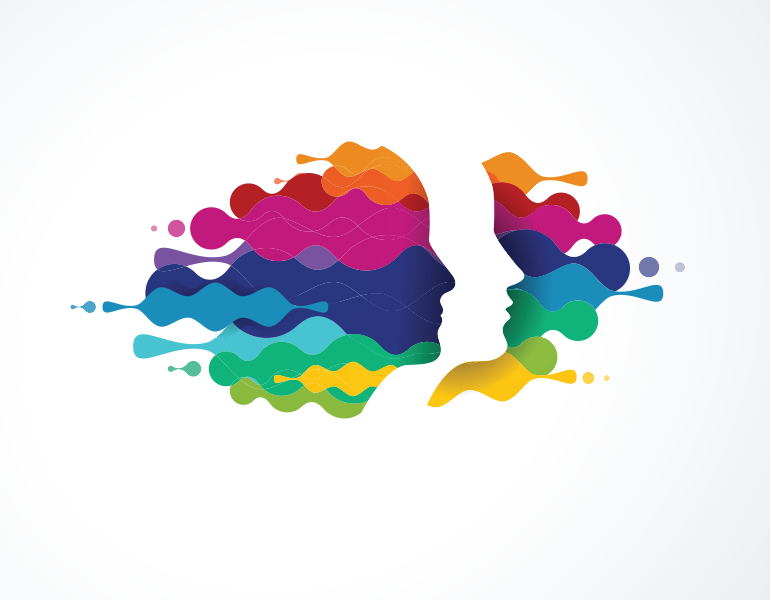Are you artistic?
Nah, I can't draw a straight line.
Like me, you may have wondered what being able to draw a straight line has to do with being artistic. Well, it depends on what we mean by the term artistic. Almost everyone can use paper and pencil to draw a house. Some of these efforts will result in crude squares with a triangle roof, rectangles for windows and a door, and perhaps a chimney with a curlicue of smoke. At the other end of the artistic ability scale, the results will be drawings with shading, perspective, and texture, suitable for a real estate agent's website.
The difference in the drawings lies in the level of craftsmanship displayed. The skillful artist can draw a straight line, at least when a straight line is needed. And the value of craftsmanship, in art as in other endeavors, should not be discounted. Most of us want our lab technicians, airline pilots, electricians, and accountants to be skilled craftspeople—"in-the-box" thinkers whose skills reflect the best practices of their professions.
But today, with technology making it increasingly possible to automate and outsource craftsmanship, educators need to think about how we can encourage that more personal component of art (and of high accomplishment in other endeavors): creativity.
Is It Creativity, or Just Nifty Technology?
Nearly every list of 21st century skills mentions creativity as important to success, even survival. Richard Florida's The Rise of the Creative Class (Basic Books, 2002) and Daniel Pink's A Whole New Mind (Riverhead, 2004) point to creativity as not just a nice extra for those working in the arts or entertainment, but a career and college readiness skill for all.
We may believe that technology is helping students become more creative. After all, aren't we seeing even our youngest students use applications and websites to produce visually stunning products? But it's not necessarily so.
Consider the image in Figure 1. It took under a minute and no thought whatsoever to paste the text from this "Power Up" column into the free online program Wordle. The website then generated the cloud. It looks pretty classy, and readers unfamiliar with Wordle may assume I am a talented, creative person. I can "create" similar professional-looking graphics using dozens of online tools—poster makers, cartoon creators, avatar builders, infographic generators, and so on. When making a slide show, I can use the clip art, styles, and templates that come with Power Point and find thousands more online. Stock photos relieve me of the task of taking relevant photographs to illustrate concepts.
Figure 1. An Instant Word Cloud from Wordle
Here's the question I've been asking myself: When technology enables a person to make something that looks professional without having to master any degree of craft, does that increase or decrease the likelihood of creativity? And can educators be lulled into a false impression that they have been developing creativity in students when using technologies that produce brilliant-looking results? Does my Wordle cloud give only the illusion of creativity?
Avoiding the False Creativity Trap
A number of software applications are aligned to the "creating" level of Bloom's taxonomy—for example, animation programs like Flipbook, video-editing programs like iMovie, and storytelling programs like Toontasic. However, no technology can guarantee creative output. How is giving a child access to the drawing program Kidpix different from giving a child a coloring book and praising him or her for staying in the lines?
Here are some ideas to help educators avoid creating the illusion of creativity.
- Discourage use of built-in graphics and clip art. Images can communicate in powerful ways, and students should be encouraged to use them in their projects. But the images should not come from a program's bank of premade art or simply be downloaded from the Internet. Ask students to draw and scan their own images or use an online drawing program to create original art. Expect them to take digital photos and edit them using free online tools like Pixlr or Fotor.
- Choose tools that require original materials. Photo- and video-editing programs like Animoto, Prezi, and Big Huge Labs Motivator have no built-in images with which to work, so students must provide the raw materials themselves.
- Choose devices that enable students to make original work. Tablet computers with microphones, front- and rear-facing cameras, and image-editing software are good choices for educators asking students to communicate creatively in multiple formats. Full-size computers with mechanical keyboards, more powerful processors, and ports for external accessories like drawing pads are better for students who are writing, using CAD/CAM drafting software, or coding.
- Make creativity part of assessment. Susan Brookhart writes, "What's missing in many classrooms is deliberately noticing and naming opportunities for creativity when they occur, giving feedback on the creative process, and teaching students that creativity is a valued quality." It can be difficult to judge whether a product or action is creative, but teachers can strive to do this by including creativity as a criterion in assessment rubrics, using multiple evaluators to judge the level of creativity, and asking for a student's explanation of the relationship of originality to the overall effectiveness of the work.
Perhaps most important, we need to convey to students that creativity is valuable as the means to an end, not as an end in itself. One often overlooked element of creativity is that a "creative" product is not only original or impressive looking, but also effective in achieving an intended outcome. When creativity is employed to convince a reader or viewer of a point of view, solve a meaningful problem, communicate more clearly, or increase attention and engagement, the quantity and quality of creativity increase.
The nifty new technologies we teach our children to use will not guarantee learning products that are original, innovative, or inventive. But used in combination with good teaching practices, they can motivate and encourage creativity in all learners.



